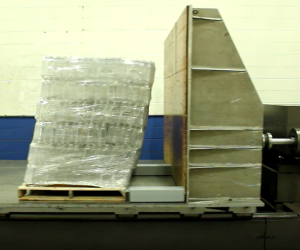What is EUMOS 40509?
EUMOS 40509 is a testing method referenced in the European Directive 2014/47/EU. EUMOS 40509 is designed to test and quantify the horizontal rigidity of unit loads being transported inside trucks.
In simple terms, the goal of EUMOS 40509 is to determine whether a given load is at risk of toppling in the event of sudden braking, wide turns, or other events that could compromise the stability of the load. Because much of Europe uses soft-sided trucks for road transportation, fallen cargo could break through the sidewalls of a truck and spill onto the road. EUMOS 40509 leverages forces that could trigger such an event in a controlled laboratory environment. This allows manufacturers to test different designs and bracing and blocking methods for their packaging and determine which iteration is rigid enough to withstand some of the lateral forces that could be encountered on the road.
How is EUMOS 40509 enforced?
It varies by country but at this time, it doesn’t appear to be necessary for companies to submit paperwork proving that they’ve tested to EUMOS 40509. Roadside inspections do occur, ensuring vehicle operators are meeting the roadworthiness requirements as defined in EU Directive 2014/47/EU. Although most of the Directive focuses on the roadworthiness of the vehicle itself, cargo securement is also in scope. The Directive requires that cargo is secure and loads only minimally change their position during transport. Annex III of the Directive notes that cargo securing shall prevent tilting / tipping if subjected to 0.8 g in the driving direction and 0.5 g in the lateral direction. Cargo is subject to roadside inspections, and vehicle operators are responsible for ensuring their cargo is safe and secure.
Although operators can meet the requirements of the EU Directive with various securement methods, a lot of packaging designers are leveraging EUMOS 40509 and ISTA Horizontal Impact Testing for Unrestrained Loads to understand the sidewall rigidity of their individual units loads. Designing with sidewall rigidity in mind helps mitigate the risk of load stability issues that may result in accidents or fines levied during roadside inspections.
Ultimately, testing to EUMOS 40509 does not appear to be a requirement, but stable and secure load during transport is. Tests like EUMOS 40509 and ISTA Horizontal Impact Testing for Unrestrained Loads are tools for packaging designers to use to
reduce the likelihood of stability issues occurring.
Is there a North American equivalent to EUMOS 40509?
Formally, no. There are several reasons for this.
The first is the difference between the North American and European trucking industries. Most North American trucks carry trailers and or shipping containers with solid sides, often metal. If a load were to topple while in transit, cleanup could be messy and time-consuming, but unless a collapse dramatically altered the weight distribution—and, thus, balance—of the truck, the risk of danger to others on the road is fairly minimal.
In Europe, however, cargo trucks have soft-sided trailers. The tarpaulin sides and locking systems protect the cargo from weather, road debris, and tampering. However, tarpaulin material cannot always withstand the weight of fallen cargo. If a unit load were to topple inside a soft-sided tailer, the cargo could break through the tarpaulin sides and fall to the road—or on top of a nearby vehicle. Load stability tests like EUMOS 40509 exist to help shipping and logistics companies get the data they need to reduce the risk of this happening.
The second reason is that the EU historically has progressed more with package lightweighting initiative than North America. Lightweighting packaging can drastically affect sidewall rigidity, and historical test methods do not address this properly.
The third reason why there is no North American equivalent to EUMOS 40509 is a dearth of testing equipment. EUMOS 40509 can only be conducted on a specific variety of test sled. Currently, that type of equipment is not available in any commercial labs in North America. It is expected that this capacity will soon become available. ISTA has published an alternative test—ISTA Horizontal Impact Testing for Unrestrained Loads—that leverages equipment more commonly found. Although this test is not referenced in EU directive 2014/47/EU, it is a tool widely available to assess load stability.
What does this mean for North American companies who want to ship products in Europe?
Needless to say, plenty of North American manufacturers want to ship their products to Europe and transport them throughout the continent in trucks. But shipping a pack back and forth from Europe for testing in a European lab can be both cost- and time-prohibitive, especially if it takes several rounds of adjustments to achieve the desired results. Many North American manufacturers may be looking for an alternative closer to home, a way to understand how stable their unit loads are without leaving the continent. These manufacturers are free to leverage the ISTA test, but some want to understand how their pack will perform against EUMOS 40509 specifically.
Smithers has years of experience conducting and developing load stability test methods. We’ve developed a new test method that loosely mimics EUMOS 40509 by recreating the forces outlined in EUMOS 40509 on a

different type of horizontal impact sled, located at our laboratory in Lansing, Michigan. Our goal was to create a method that allows manufacturers to predict the performance of their pack against the forces outlined in the EU directive without having to ship it back and forth across the Atlantic Ocean multiple times. Instead, manufacturers can do most of that work here in the United States, with the support of the expert team at Smithers.
The test method developed by Smithers allows you to gain an understanding of how your pack design responds to latitudinal and longitudinal forces as stated in the EU directive by conducting a EUMOS 40509-based test —without having to ship pack design samples to Europe.

 different type of horizontal impact sled, located at our laboratory in Lansing, Michigan. Our goal was to create a method that allows manufacturers to predict the performance of their pack against the forces outlined in the EU directive without having to ship it back and forth across the Atlantic Ocean multiple times. Instead, manufacturers can do most of that work here in the United States, with the support of the expert team at Smithers.
different type of horizontal impact sled, located at our laboratory in Lansing, Michigan. Our goal was to create a method that allows manufacturers to predict the performance of their pack against the forces outlined in the EU directive without having to ship it back and forth across the Atlantic Ocean multiple times. Instead, manufacturers can do most of that work here in the United States, with the support of the expert team at Smithers.